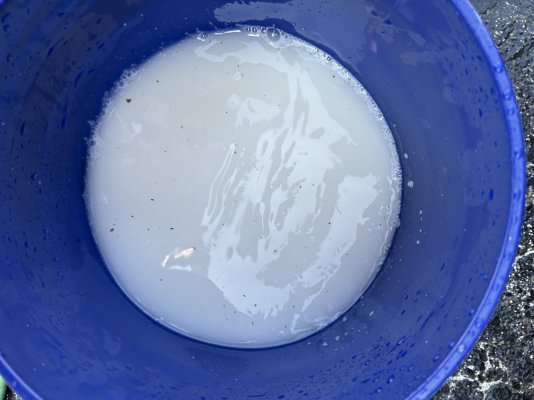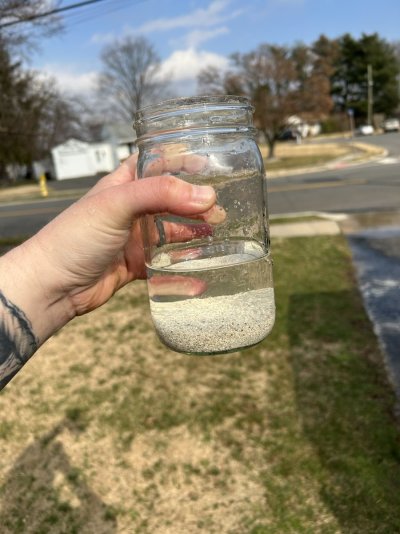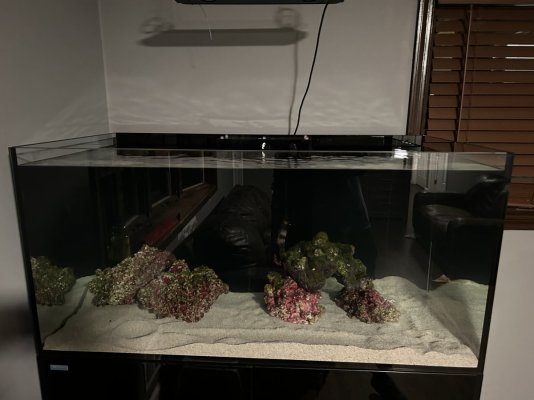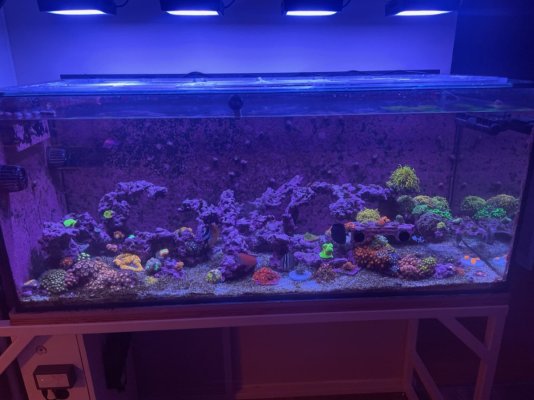Probably wouldn't come out looking as clean as it did without the effort put into this thread by you and others!You know why I'm impressed? Because that final assembly tank looks empty/ no water/ that's the sign of one heck of a pre rinse! Well done and thank you so much for the pictures and documentation this is really looking sharp
Navigation
Install the app
How to install the app on iOS
Follow along with the video below to see how to install our site as a web app on your home screen.
Note: This feature may not be available in some browsers.
More options
You are using an out of date browser. It may not display this or other websites correctly.
You should upgrade or use an alternative browser.
You should upgrade or use an alternative browser.
Official Sand Rinse and Tank Transfer thread
- Thread starter brandon429
- Start date
- Tagged users None
It’s been a long day I’ll give better updates tomorrow but here’s some pics of the tank tank transfer so far … rinsing sand from milk to crystal clear!
Attachments
That’s 100% crystal clear thank you very much for the updates I knew you’d power rinse it 
I wonder if it’s true that reef flakes brand sand doesn’t need pre rinsing, I’ve heard that before. Caribsea is the milk king for sure, wonder about rf
A new rip clean completed by DNR88 at nano-reef.com:
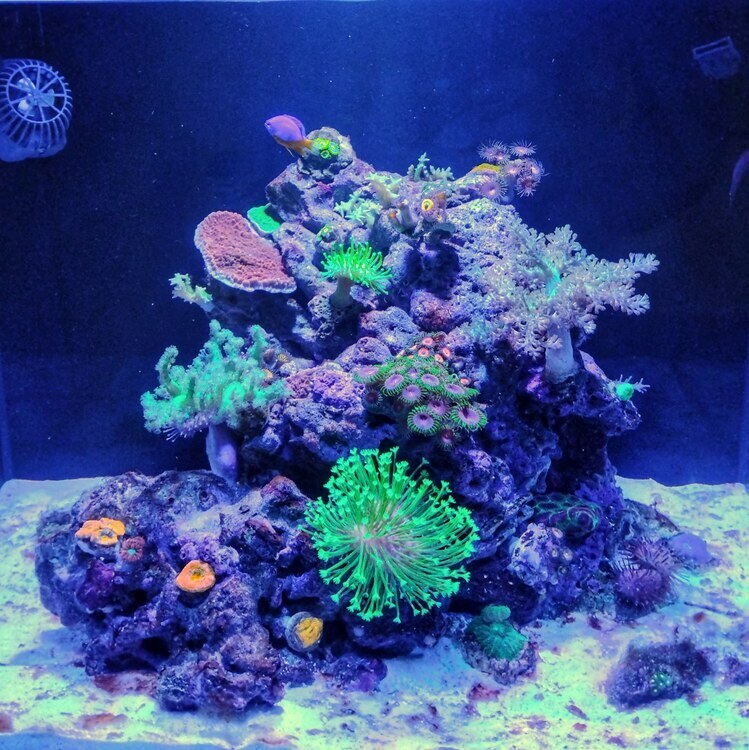



I wonder if it’s true that reef flakes brand sand doesn’t need pre rinsing, I’ve heard that before. Caribsea is the milk king for sure, wonder about rf
A new rip clean completed by DNR88 at nano-reef.com:

DNR88's Blue Marine Reef 90 (24 gallon) - Sand bed rinsed
Soo, here we are with something new. Goodbye to the Blue Marine 60 and hello to the Blue Marine Reef 90 with 24 gallon . That's a 50 percent increase! Latest FTS (2023-03-20). After the sand bed rinsing (2023-02-26) Older Inhabitants: - NEW! Two Azure Damselfish - Six line wrasse - Halloween he...
www.nano-reef.com
Last edited:
Might be worth it to get a small bag and see as an experiment? This sand was new caribsea dry agaronite, it was like milk the first several rinses and had random sediment and particles that floated up to the top at first. Very dirty.That’s 100% crystal clear thank you very much for the updates I knew you’d power rinse it
I wonder if it’s true that reef flakes brand sand doesn’t need pre rinsing, I’ve heard that before. Caribsea is the milk king for sure, wonder about rf
@brandon429 whats your thoughts on going from a 1+ year tank and transfer to new tank no sand but cleaning rocks all rocks from dt? I think I should be fine but I am curious about the loss of bacteria. I have a good bit of rock and 2 4x8 marine pure blocks I can transfer to the new sump too
If I can interject, swish all the crud out of your rocks, you’ll be grand. Any increase in ammonia, if any, will be minuscule.@brandon429 whats your thoughts on going from a 1+ year tank and transfer to new tank no sand but cleaning rocks all rocks from dt? I think I should be fine but I am curious about the loss of bacteria. I have a good bit of rock and 2 4x8 marine pure blocks I can transfer to the new sump too
For anyone curious how to rinse sand, post #83 by Marc levenson from 2016 just about sums it up, lol
On my new build I used new Caribsea Fiji pink live sand and rinsed it. 100 pounds worth. It took a while but was so very worth it.
@DReef42 hey can you post a pic of the tank and rocks that will be moved over
I rate biobricks as absolutely not core or crucial surface area in the matter, they aren’t integral to the system even if it’s bare bottom. Cleaning the rocks as we do, with metal tools and rasping of surfaces plus some spot peroxide doesn’t harm bacteria it’s been our staple method for a long time
it takes true drying, or days submerged in refreshed tap water, or boiling or freezing to strip rocks of cycling bacteria in impactful ways.
@mrpontiac80 thank you for posting that, it shows even large tank owners can command their tank clarity with enough resolve. That’s a huge amount of sand to pre rinse ~
I rate biobricks as absolutely not core or crucial surface area in the matter, they aren’t integral to the system even if it’s bare bottom. Cleaning the rocks as we do, with metal tools and rasping of surfaces plus some spot peroxide doesn’t harm bacteria it’s been our staple method for a long time
it takes true drying, or days submerged in refreshed tap water, or boiling or freezing to strip rocks of cycling bacteria in impactful ways.
@mrpontiac80 thank you for posting that, it shows even large tank owners can command their tank clarity with enough resolve. That’s a huge amount of sand to pre rinse ~
Sorry if this has been asked before (this thread is huge and haven't read all the comments yet) but do you know if there is any harm in taking out all the sand from your display tank and giving it a good rinse and putting it back in?
So it won't be a full rip clean, I have a large tank and can't do a 100% water change I just don't think that's feasible for myself.
So it won't be a full rip clean, I have a large tank and can't do a 100% water change I just don't think that's feasible for myself.
@Create New
lots of people try and remove sand from fully running tanks via shop vacs or other means, it has variable safety outcomes. Some tanks will crash due to that method because of the inevitable waste cloud that results in the water column during removal
the majority of systems can endure that type of removal but a subsection of those will have enduring invasion issues from the waste distribution event.
structured / ordered disassembly of the tank first is what we do, leaving sand removal until the very last step after all animals rocks and corals are out of the tank and held separately
this allows for skip cycle cleaning every time and it never causes tradeoff or delayed invasions we show in the outcome picture logs
disassembly cleaning is 100% safe for all tanks though it is hard work and takes time. Let’s see your reef, post a pic of the tank you wanted to clean sometimes the pics show unspoken details we can use to do custom job change ups
lots of people try and remove sand from fully running tanks via shop vacs or other means, it has variable safety outcomes. Some tanks will crash due to that method because of the inevitable waste cloud that results in the water column during removal
the majority of systems can endure that type of removal but a subsection of those will have enduring invasion issues from the waste distribution event.
structured / ordered disassembly of the tank first is what we do, leaving sand removal until the very last step after all animals rocks and corals are out of the tank and held separately
this allows for skip cycle cleaning every time and it never causes tradeoff or delayed invasions we show in the outcome picture logs
disassembly cleaning is 100% safe for all tanks though it is hard work and takes time. Let’s see your reef, post a pic of the tank you wanted to clean sometimes the pics show unspoken details we can use to do custom job change ups
It's shameful and embarrassing but here she is, warts and all.disassembly cleaning is 100% safe for all tanks though it is hard work and takes time. Let’s see your reef, post a pic of the tank you wanted to clean sometimes the pics show unspoken details we can use to do custom job change ups
I don't know if I'll be able to do anything this weekend - also I don't know where I'd start haha, I only have 2 75 litre drums I use for water changes so I don't know where I'd put my fish, rocks and sand if I was to do a rip clean.
Here’s the display I bought 150lbs of dry rock and used almost all of it@DReef42 hey can you post a pic of the tank and rocks that will be moved over
I rate biobricks as absolutely not core or crucial surface area in the matter, they aren’t integral to the system even if it’s bare bottom. Cleaning the rocks as we do, with metal tools and rasping of surfaces plus some spot peroxide doesn’t harm bacteria it’s been our staple method for a long time
it takes true drying, or days submerged in refreshed tap water, or boiling or freezing to strip rocks of cycling bacteria in impactful ways.
@mrpontiac80 thank you for posting that, it shows even large tank owners can command their tank clarity with enough resolve. That’s a huge amount of sand to pre rinse ~
Attachments
@DReef42 I am 100% sure those rocks will transfer over without a recycle, simply omit the sand from the final assembly
feel free to drain and capture and use half or so of your current water, that saves makeup water work and your tank isn’t invaded or distressed in any way, it’s ok to use some current water in the new setup
don’t use any clouded water from the bottom of the tank as it drains down
the most important part is to move clean items, make sure the rocks don’t have adhered muddy detritus stuck to the bottom, to remove any attached algae you’d scrape it with a knife tip and rinse away in saltwater plus you’d apply peroxide only to the scraped growth areas in a precision manner, very exacting and clean.
even if you removed some of the rocks, and the sand, and didn’t move over the marine pure bricks the system still would skip cycle because 75 pounds of cured rock directly in the display carries any bio load in reefing. That’s hard to imagine considering the training old cycling science gave us, that no surface area could be removed without a cycle (false information) but we build this thread on updated cycling science that knows we are all using many times more live rock than what’s needed for our bioloads, we are free to remove a hefty portion without consequence as long as no waste clouding up wells in the system, that’s the cardinal rule keeping all the reefs in this thread safe.
feel free to drain and capture and use half or so of your current water, that saves makeup water work and your tank isn’t invaded or distressed in any way, it’s ok to use some current water in the new setup
don’t use any clouded water from the bottom of the tank as it drains down
the most important part is to move clean items, make sure the rocks don’t have adhered muddy detritus stuck to the bottom, to remove any attached algae you’d scrape it with a knife tip and rinse away in saltwater plus you’d apply peroxide only to the scraped growth areas in a precision manner, very exacting and clean.
even if you removed some of the rocks, and the sand, and didn’t move over the marine pure bricks the system still would skip cycle because 75 pounds of cured rock directly in the display carries any bio load in reefing. That’s hard to imagine considering the training old cycling science gave us, that no surface area could be removed without a cycle (false information) but we build this thread on updated cycling science that knows we are all using many times more live rock than what’s needed for our bioloads, we are free to remove a hefty portion without consequence as long as no waste clouding up wells in the system, that’s the cardinal rule keeping all the reefs in this thread safe.
@Create New
yours is a special job for sure, we need to brainstorm options before initiating the works. That’s a beautiful tank anyone would be proud to have it, I can see some low-lying growths on the rocks and some light cyano on the sand, it’s a huge tank that’s not easy to run disassembly cleaning for sure. We need to brainstorm other options for your eutrophication repair
notice your sandbed cross section in the areas it’s raised above the bottom edge of the tank, it’s not full of blackened waste, the sandbed is not terribly aged requiring the full rinse we usually do, hope this provides some hope in the matter. It’s a relatively shallow sandbed for sure, relatively clean and the reef isn’t exceptionally high bioload either. Right off the bat: your lighting levels are implicated
those corals you have don’t require this level of brightness and white spectrum the pic shows, this level of power selects for green algae and sandbed growth, your lighting power should be dropped and held for 60 days minimum in assessment, after we custom clean the growths out of the tank. Less whites, less overall power held for two months will not hurt those corals at all. Lighting is driving a lot of your challenge.
fluconazole is a powerful target killer of green algae, it can play a role in assisting us here. There is a six hundred page fluc thread stickied at the top of the nuisance algae forum, notice it’s trend: kill algae, bring on six months of horrible cyano, over and over for years.
we must not do that to your tank / must anticipate the pattern outcomes from that med and shape its use here differently
the masses simply take an algae reef, skip cleaning it, dose fluc which certainly kills green algae, it dies and rots off adding to the current waste loading, and the combined rot + no change in tank stasis brings on massive cyano and dinos wrecks, fluc trades off a gha issue for a matted invader issue when used the common way.
we started right off changing your tank stasis, the lighting as a beginning change away from the prior condition that favors algae and cyano
next up is UV filter. Since the tank is too big to deep clean that effort must be translated into something mechanical and the UV light filter is what you want: that specifically changes tank stasis by burning our cyano and dinos cells and will be crucial in you getting a predictable change in that reef without having to disassembly clean it. Since we are contemplating doing in-tank work, the #1 thing we haven’t done in this thread, we need to anticipate invader cells being cast around the tank even though we are about to clean it in a very customized way. You need to secure the right UV filter for that tank among the options and install it before we begin, it’s crucial and it’s the price to pay for not being able to disassembly clean the system.
UV gives me a 95% positive return on investment in tank repair jobs which is why I’m pressing for it here.
notice your back wall algae: not on the sides but in the middle where light hits strongly and breaks into shimmer
that’s handy, you don’t have a full back or front or sides to scrape, only middle back area.
get a long siphon hose and tape it to the end of a long wooden dowel rod, stick the dowel rod out about an inch past the end of the siphon hose and tape them at the end and in the middle so you have a reinforced siphon hose that is straight and aimable
cut an angled split in the end of the wooden dowel rod, affix in a common razor blade for scraping algae at the correct slight angle
this gives you a firm scraping tool on extension, with a *suction* hose right at the base of the razor taped in place
you would turn off pumps and still the tank, we are trying not to cast algae everywhere as you remove it from that back wall. We aren’t using a med to kill the algae and let it float away, we are truly exporting it because that’s safer and worth the work to prevent tradeoff invasions.
now that the tank is stilled you would begin the siphon and then slowly scrape down and each pass will cleanly remove algae and suction it out vs cast it around the tank. I’ve had people use this method in big tanks and it works well. You’re still needing plenty of new water made for the siphon exchanges but this is far less water than a rip clean requires and your fish can stay, the corals can stay in the tank. Your sandbed isn’t so dirty that this is a risk, that’s a pretty darn clean sandbed you have with some minor top growth.
this will now have your back wall completely clean and exported of algae which is fragmenting around the system currently; it will be gone using export which is the right way in increments to fix that tank
next up post is rocks and sand cleaning and special fluc application to save you from disassembly cleaning. Big post in two parts coming up
yours is a special job for sure, we need to brainstorm options before initiating the works. That’s a beautiful tank anyone would be proud to have it, I can see some low-lying growths on the rocks and some light cyano on the sand, it’s a huge tank that’s not easy to run disassembly cleaning for sure. We need to brainstorm other options for your eutrophication repair
notice your sandbed cross section in the areas it’s raised above the bottom edge of the tank, it’s not full of blackened waste, the sandbed is not terribly aged requiring the full rinse we usually do, hope this provides some hope in the matter. It’s a relatively shallow sandbed for sure, relatively clean and the reef isn’t exceptionally high bioload either. Right off the bat: your lighting levels are implicated
those corals you have don’t require this level of brightness and white spectrum the pic shows, this level of power selects for green algae and sandbed growth, your lighting power should be dropped and held for 60 days minimum in assessment, after we custom clean the growths out of the tank. Less whites, less overall power held for two months will not hurt those corals at all. Lighting is driving a lot of your challenge.
fluconazole is a powerful target killer of green algae, it can play a role in assisting us here. There is a six hundred page fluc thread stickied at the top of the nuisance algae forum, notice it’s trend: kill algae, bring on six months of horrible cyano, over and over for years.
we must not do that to your tank / must anticipate the pattern outcomes from that med and shape its use here differently
the masses simply take an algae reef, skip cleaning it, dose fluc which certainly kills green algae, it dies and rots off adding to the current waste loading, and the combined rot + no change in tank stasis brings on massive cyano and dinos wrecks, fluc trades off a gha issue for a matted invader issue when used the common way.
we started right off changing your tank stasis, the lighting as a beginning change away from the prior condition that favors algae and cyano
next up is UV filter. Since the tank is too big to deep clean that effort must be translated into something mechanical and the UV light filter is what you want: that specifically changes tank stasis by burning our cyano and dinos cells and will be crucial in you getting a predictable change in that reef without having to disassembly clean it. Since we are contemplating doing in-tank work, the #1 thing we haven’t done in this thread, we need to anticipate invader cells being cast around the tank even though we are about to clean it in a very customized way. You need to secure the right UV filter for that tank among the options and install it before we begin, it’s crucial and it’s the price to pay for not being able to disassembly clean the system.
UV gives me a 95% positive return on investment in tank repair jobs which is why I’m pressing for it here.
notice your back wall algae: not on the sides but in the middle where light hits strongly and breaks into shimmer
that’s handy, you don’t have a full back or front or sides to scrape, only middle back area.
get a long siphon hose and tape it to the end of a long wooden dowel rod, stick the dowel rod out about an inch past the end of the siphon hose and tape them at the end and in the middle so you have a reinforced siphon hose that is straight and aimable
cut an angled split in the end of the wooden dowel rod, affix in a common razor blade for scraping algae at the correct slight angle
this gives you a firm scraping tool on extension, with a *suction* hose right at the base of the razor taped in place
you would turn off pumps and still the tank, we are trying not to cast algae everywhere as you remove it from that back wall. We aren’t using a med to kill the algae and let it float away, we are truly exporting it because that’s safer and worth the work to prevent tradeoff invasions.
now that the tank is stilled you would begin the siphon and then slowly scrape down and each pass will cleanly remove algae and suction it out vs cast it around the tank. I’ve had people use this method in big tanks and it works well. You’re still needing plenty of new water made for the siphon exchanges but this is far less water than a rip clean requires and your fish can stay, the corals can stay in the tank. Your sandbed isn’t so dirty that this is a risk, that’s a pretty darn clean sandbed you have with some minor top growth.
this will now have your back wall completely clean and exported of algae which is fragmenting around the system currently; it will be gone using export which is the right way in increments to fix that tank
next up post is rocks and sand cleaning and special fluc application to save you from disassembly cleaning. Big post in two parts coming up
@DReef42
Don't forget to re ramp your lights on a seven day acclimation run and don't wind up at this same power level you're at currently for a while, that's core safety planning for corals to avoid lightening and bleaching. You can move the half old /new water to the new tank along with cleaned rocks, the fish and corals and clean up crew, and it'll skip cycle even with no sand transferred. Don't transfer over full production level lighting power that's key to your safe transfer.
Don't forget to re ramp your lights on a seven day acclimation run and don't wind up at this same power level you're at currently for a while, that's core safety planning for corals to avoid lightening and bleaching. You can move the half old /new water to the new tank along with cleaned rocks, the fish and corals and clean up crew, and it'll skip cycle even with no sand transferred. Don't transfer over full production level lighting power that's key to your safe transfer.
@Create New
I want to show you something regarding reef tank light levels and coral response using my friends very old ten year fishbowl pico reef.
We are all trained and told: brightest PAR levels for coral growth. Bright, open natural reefs are our copy models
That is causing such significant algae growth for the masses, your light levels are a big deal in your issue. Compare your full tank shot/ light levels to this simple bowl that hasn't had one tuft of algae to clean in ten years:
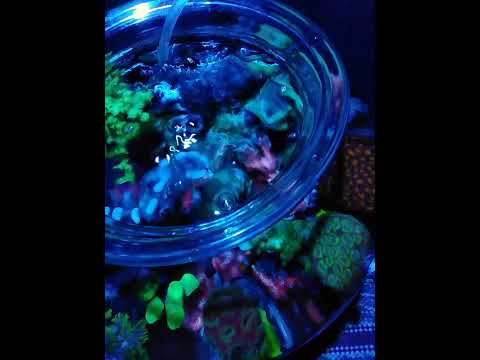
 youtube.com
youtube.com
Look at how muted and shaded and blue vs white that system is comparatively
Yet all that $$ top shelf sps coral in shading isn't missing skin, it's just perfect
Feeding quality drives that system not brightness.
I want to show you something regarding reef tank light levels and coral response using my friends very old ten year fishbowl pico reef.
We are all trained and told: brightest PAR levels for coral growth. Bright, open natural reefs are our copy models
That is causing such significant algae growth for the masses, your light levels are a big deal in your issue. Compare your full tank shot/ light levels to this simple bowl that hasn't had one tuft of algae to clean in ten years:

Maritza The Vase Reef 2021 Going ðªð
Look at how muted and shaded and blue vs white that system is comparatively
Yet all that $$ top shelf sps coral in shading isn't missing skin, it's just perfect
Feeding quality drives that system not brightness.
@Create New
I want to show you something regarding reef tank light levels and coral response using my friends very old ten year fishbowl pico reef.
We are all trained and told: brightest PAR levels for coral growth. Bright, open natural reefs are our copy models
That is causing such significant algae growth for the masses, your light levels are a big deal in your issue. Compare your full tank shot/ light levels to this simple bowl that hasn't had one tuft of algae to clean in ten years:

Maritza The Vase Reef 2021 Going ðªð
youtube.com
Look at how muted and shaded and blue vs white that system is comparatively
Yet all that $$ top shelf sps coral in shading isn't missing skin, it's just perfect
Feeding quality drives that system not brightness.
Okay this is interesting to me because my LFS told me that I need more lights for a tank my size lol.
I have 3 AI hydra 32s, so if I lower the intensity and change the spectrum to more blue it will help?
This is my current settings -
You're 100% right on the medicating to solve my problem, I used Chemiclean and BOOM no cyano!...and then I get green hair algae so I use Vibrant, BOOM no GHA... and then I get cyano again! so on so fourth.
Okay so with the UV sterilizer what would you recommend? I'm very much a penny pincher but this seems like something you're positive will help my tank.
I should add I did clean the back glass the other day but got lazy and didn't do the middle piece but kinda glad I didn't as you got to see what it normally looks like and you were able to explain a better way clean it rather than scrape and let it go down the overflow and get caught in the filter roller.
It’s ok to not do UV if you need to save $ but they’re just so helpful if the money is possible
It can’t harm your setup with what we will do to skip it, worst case is you get some growback work it might otherwise zap
they don’t have to run 24x7 but they’re so helpful during battle runs if the cash is available for the elective purchase and it’s helpful for future battles. Two options:
big $$ for a pentair or emperor aquatics pro stuff, it lasts years to justify the cost/ probably $700 or so OR $140 off Amazon, cheap jebao *pond* sterilizer rated for 1500-5000 gallons, the cheap unit won’t last long maybe a year or two continuous but theyre small, impactful too and absolutely have helped me in work threads for years on end, most go this route. of course you’ll have to get a pump for it, some hosing and make some sort of install but it doesn’t have to be permanent. One fella even installed it ugly right on the hanging front lip of his tank right in the way and ran it only two months then didn’t need it anymore for his dinos. Those are the uv options, not required but very very swing vote helpful if possible because your cyano has to travel through the water to get cast about the tank, and it can be intercepted there
we would do a standard sand siphon cleaning instead of removing the tank sand we clean it via common sandbed siphon, if some/most if it comes out then we can have you wash it, and put it right back in
the point is we are hand removing the algae and the cyano physically vs in-tank kill like most do, we use the meds as growback prevention only, not removers we are the removers, growback prevention means the meds have far less target to work on and won’t be littering the tank in decayed mass.
rock cleaning up next post
It can’t harm your setup with what we will do to skip it, worst case is you get some growback work it might otherwise zap
they don’t have to run 24x7 but they’re so helpful during battle runs if the cash is available for the elective purchase and it’s helpful for future battles. Two options:
big $$ for a pentair or emperor aquatics pro stuff, it lasts years to justify the cost/ probably $700 or so OR $140 off Amazon, cheap jebao *pond* sterilizer rated for 1500-5000 gallons, the cheap unit won’t last long maybe a year or two continuous but theyre small, impactful too and absolutely have helped me in work threads for years on end, most go this route. of course you’ll have to get a pump for it, some hosing and make some sort of install but it doesn’t have to be permanent. One fella even installed it ugly right on the hanging front lip of his tank right in the way and ran it only two months then didn’t need it anymore for his dinos. Those are the uv options, not required but very very swing vote helpful if possible because your cyano has to travel through the water to get cast about the tank, and it can be intercepted there
we would do a standard sand siphon cleaning instead of removing the tank sand we clean it via common sandbed siphon, if some/most if it comes out then we can have you wash it, and put it right back in
the point is we are hand removing the algae and the cyano physically vs in-tank kill like most do, we use the meds as growback prevention only, not removers we are the removers, growback prevention means the meds have far less target to work on and won’t be littering the tank in decayed mass.
rock cleaning up next post
Similar threads
- Replies
- 1
- Views
- 60
- Replies
- 2
- Views
- 85
- Replies
- 26
- Views
- 1,197



